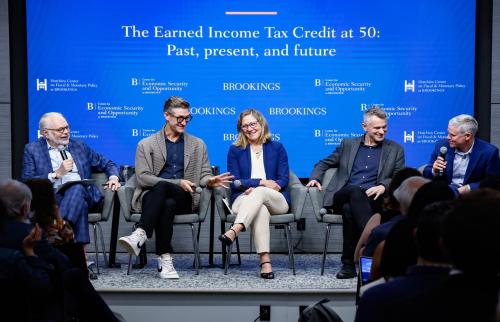Introduction
Public K-12 schools are open now for the academic year, and instruction has returned to full-time in person, despite some disruptions due to outbreaks of the highly contagious COVID-19 delta variant (Burbio School Opening Tracker). The anticipation has been that with schools reopening, women with young children—who have disproportionately dropped out of and remained out of the labor force since the start of the pandemic—will return to the labor force. However, the small bit of evidence provided by the labor market data in September suggests that this is not the case, as the aggregate labor force participation rate roughly moved sideways and the rate for women ticked down. In this post, we speak to this question by examining the extent to which the switch to all-virtual and hybrid schooling during the pandemic impacted the labor force participation of women with young children. We find that increases in the share of children in virtual or hybrid schooling in a given state are associated with decreases in labor force participation among women with young children in that state. However, the effects are modest. Moreover, in our data, remote schooling also depresses the participation of men with young children, all else equal, so it cannot entirely explain the relatively low participation of women with young children since the start of the pandemic. From a policy perspective these findings indicate that the reopening of schools will not be enough to return mothers’ labor force participation back to its pre-pandemic levels. Indeed, mothers, like women more generally, have faced many challenges since the onset of the pandemic. In particular, they were over-represented in the service occupations that were hardest hit when the economy shut down at the start of the pandemic, and as such, conditions related to the progress of the pandemic and the reopening of the economy will also play an important role in increasing their participation. More generally concerns about the progress of the pandemic are likely to be a continuing factor in labor force decisions, especially for parents with young children who cannot be vaccinated.
Traditional labor force dynamics will also slow the return of mothers into the labor force. Research shows that people who are out of the labor force have lower probabilities of transitioning into employment than those who are unemployed and that their return to the labor force often lags overall improvement in the economy. This occurs both because people who are out of the labor force make commitments that keep them out of the labor force (for instance deciding to stay home until a child starts school or entering school themselves) and because employers may be reluctant to hire those with gaps in their employment history or their networks may weaken.
The labor force participation of mothers since the start of the pandemic
As has been extensively covered, labor force participation among women dropped significantly at the start of the COVID-19 pandemic, and this was especially true for women with young children (see figure 1). Here, and in the analysis below, we focus on prime age workers—those ages 25-54—to limit the number of factors that could be affecting participation, in particular the lower likelihood that this group is driven by decisions around schooling and retirement. Immediately after the economy started to close in March 2020, the participation rate of women with young children fell nearly 6 percent, while the participation rate of women and men without young children fell by 4 percent. Even as GDP reached its pre-pandemic level and the aggregate unemployment rate fell to 5.4 percent in July, the labor force participation rate of women with young children moved sideways over the past year and remains about 3 percent below its pre-pandemic level. The participation rate of women without young children had risen by more than that of women with children, but by July it was also about 3 percent below its pre-pandemic level. In contrast, the labor force participation rate of men with young children was back to its pre-pandemic level in July and that of men without young children was just 1.5 percent below.

Given the disparate impact of the pandemic on the participation of mothers of young children, it seems logical to conclude that the reduction can be at least partly attributed to increased childcare responsibilities stemming from the shift to virtual learning at schools and the closure or reduced capacity of many daycare centers. Even uncertainty about the durability of the school reopenings this fall—for instance, if children suddenly have to quarantine due to an outbreak—could make it difficult for parents to perform certain jobs and may make them reluctant to return to work altogether.
Impact of school closures on mother’s labor force participation
To test whether the shift to virtual learning really can explain the decline in participation among mothers, we analyzed whether the evolution of labor force participation rates for men and women with and without young children can be explained by state variation in virtual schooling. A detailed description of our data can be found in the online appendix, but here we provide a summary of our data and method.
The data on labor force participation were calculated from the monthly CPS data. For this analysis we divided the sample into men and women by presence of young children—those younger than 13. Individuals with children older than 13 were grouped with those without children.1
The information on virtual schooling primarily comes from Burbio’s K-12 School Opening Tracker. Burbio monitors 1,200 school districts, including the 200 largest. From August 2020 on, Burbio provides weekly data on the percent of K-12 students in a district who were attending public school in a traditional (in-person), completely virtual, or hybrid (combining some virtual and some in-person learning) format. The fact that the data allow us to distinguish between full-time at-home schooling and part-time is an advantage, since women’s and men’s labor force participation decisions may vary depending on the intensity of childcare demands these situations represent. We use the Burbio data for the months of September 2020 through June 2021. To aggregate the data to state level, we weight the school districts using K-12 public school enrollment, provided by Burbio. We then create monthly variables that correspond to the CPS, by averaging the data in the weeks leading up to and including the CPS survey reference week.2 For the remainder of the months, we must make some assumptions. In January and February of 2020, we code all states as having 100 percent traditional schooling. For the month of March 2020, we follow Heggeness (2020) in coding states as having been 100 percent traditional or 100 percent virtual depending on whether the state closed its schools before or after the week including March 12 (the reference week for the March CPS).3 We code all states as 100% virtual in April, May and June of 2020.4 We exclude the months of July and August 2020 from our regressions as all or nearly all schools were closed during the relevant weeks for summer vacation.5
Figure 2 displays the variable for the percent of students in virtual learning by month and state. As can be seen, there is considerable variation in the data. In the spring, schools shifted to virtual learning in two distinct blocks: before the week including March 12 or after that week but before the week including April 12. After the summer, there were states where all the schools were open beginning in September and others where students learned virtually from September through February. Most states are somewhere in between, and there is some variation over time even within states.
While the data on school operations provide a good measure of the childcare responsibilities faced by women with young children, we face the problem that these variables could be correlated with unobserved policies or events at the state level that might also affect the labor force participation. For instance, labor force could be boosted in states that opened schools to in-person learning earlier if these states also opened up economic activity early.6 Alternatively, both in-person schooling and labor force participation could be related to the status of the pandemic in a state. One way we resolve this is by comparing the labor force outcomes between several groups: women with and without young children and men with and without young children in different states. In addition, we include a series of control variables, including state fixed effects, cubic state time trends meant to capture the evolution of the pandemic and economic conditions in the state, and month fixed effects, which capture both aggregate economic conditions and seasonality. We also include a set of control variables including age, education, race, and occupation to account for differences across groups. Since our schooling variable is at the state level, we aggregate our data by state, with data aggregated up to the state/group/month level. The regression is run on data from January 2020 through June 2021, omitting the months of July and August 2020, as explained above. We weight the regression using the population of each group in the given state-month.7
Robustness
As discussed above, the Burbio data on virtual and hybrid learning is not available for the spring 2020 school year. Although schools nationally did close that March and the vast majority stayed closed through the end of the school year, our classification for these months is blunt: there is no variation in our virtual variables across states from April through June. Moreover, there is no hybrid learning taking place at all. For this reason, we reran our results using only data from September on. The results for hybrid learning were very similar to those estimated over the entire period—an increase in hybrid learning was associated with lower participation rates for parents. For virtual learning the results were still negative for all the groups, with an added negative (albeit not statistically significant) effect for mothers of young children only.
As an additional robustness check, we used an alternative measure of in-person schooling that estimates school openness based on visits to the elementary schools gleaned from a sample of mobile phone records. The results are consistent with those using the Burbio data: States with greater foot traffic around their schools had higher labor force participation rates, although there is no added impact on the labor force participation of mothers with young children.
Results
Overall, the results indicate that a high level of virtual learning in a state is associated with reduced labor force participation for men and women, with and without children, and the effect is statistically significant at least at the 10 percent level. However, the impact on labor force participation is very small—close to zero using data covering the whole pandemic, while estimates based on data from September to June indicate that a 10 percentage point increase in virtual learning decreases the labor force participation rate by half of one percentage point. On top of this aggregate effect, there is an additional small negative effect for women with young children, although it is not statistically different from the comparison group or other groups. Efforts to control for state economic and health conditions directly yielded similar effects.8
It is difficult to determine whether the weak statistical significance suggests that these results are really zero or whether the empirical analysis has low power. The consistency of the results across specifications, including the use of alternative sources of data and the inclusion of different sets of control variables, suggests that virtual and hybrid schooling really do present a barrier to participation for mothers of young children and also for fathers. However, even for these groups the ranges of estimates is small: assuming a 10 percentage point increase in hybrid and virtual learning, the 95 percent confidence interval for women with young children includes no impact at the lower bound and less than a 0.15 percentage point drag at the upper bound. An increased prevalence of hybrid learning primarily lowers the labor force participation of parents of young children—both mothers and fathers. The effect is similar in size to the impact of virtual learning and is statistically significant (albeit only at the 10 percent level). The impact of hybrid learning on the participation rates of women without young children (some of whom, nonetheless, might have school age children) is not statistically significant.
Focusing on the results from the regressions using data from September 2020 on and using the point estimates, regardless of statistical significance, the analysis suggests that the shift to virtual and hybrid schooling can account for only a small share of the drop in female labor force participation. For instance, in September 2020 about 50 percent of students were learning virtually (the blue line in Figure 2), and this held down the labor force participation rate of mothers of young children by no more than 0.3 percentage point, all else equal. Also, in September about 23 percent of students were participating in hybrid learning, which subtracted another 0.2 percentage points from the labor force participation. At that time, the labor force participation rate of mothers of young children was 3 percentage points below its pre-pandemic level, so the lack of in-person schooling could explain about one sixth of the shortfall. The results using the full time period are about on third as large. It is also worth noting that in our estimation the shift to virtual and hybrid schooling had nearly as large an impact on fathers of young children (-0.4 percentage points) and women without young children (-0.4 percentage points).
While our results suggest that the lack of in-person schooling has weighed on the labor force participation of women with young children, other factors also seem to be at play.
The small existing literature on this question is not uniform in its findings, and thus our small negative effects fit right in. Heggeness (2020) focuses on the school closures at the start of the pandemic and finds little impact on the labor force participation of mothers but some impact on other margins of employment. Work by our colleagues (Bauer et al, (2021)) focuses on the employment-to-population ratio and finds that mothers of children age 5-12 saw a greater decline in that ratio than mothers with older children and that the difference was especially large in states with more school closures. These results are not directly comparable with our results, but the direction is not inconsistent. Probably the biggest divergence in results is with Tedeschi (2020), which finds much larger impacts of school closures on the labor force participation of women with children than we do and finds little impact on the participation rates of fathers or childless women. Finally, given our findings that the lack of in-person schooling accounts for only a small share of the decline in labor force participation among women with young children and that there was little differential impact relative to fathers, our results are consistent with the work of Furman et al, (2021), which finds that the job loss among mothers of young children is not primarily driven by “parent-specific issues.”
Discussion
Our results suggest that the lack of in-person schooling had only a small impact on the low level of labor force participation among women with children. Moreover, it cannot explain very much of the relative decline in participation for mothers of young children relative to fathers of young children or other women. That said, identifying the impact of virtual and hybrid schooling on labor force participation is not easy. In part this is due to the complex interaction between the course of the pandemic across states, state economic activity, and school openings. For instance, the fact that the virtual learning variable is negative and statistically significant suggests that it could be capturing something about the economic or health conditions in the state rather than the direct impact that virtual schooling has on a parent’s ability to work, despite our control variables. And this could more generally explain the small size of the effects—that with the pandemic raging, the pace of school reopening wasn’t a significant factor for labor force participation. Just as an example, it is possible that some states that reopened schools had high COVID-19 case counts, which could have kept women out of the labor force either for personal health reasons or because they faced uncertainty about whether they would be required to take care of children who could be required to quarantine or could become ill. In this scenario, the relationship between school closure and labor force participation would be attenuated. The relationship could also be attenuated if labor force participation reacts with a lag to changes in schooling either because of the time it takes to find a job or because parents are uncertain about the durability of school openings. We do include two months of pre-pandemic data in our analysis over the full time period, so not all the variation comes from the period during the pandemic. Nonetheless, the period since the pandemic started constitutes most of our sample. If indeed the estimates reflect the broader pandemic environment, they may not be a very good estimate of the drag on labor force participation from school closures in the early phases of the pandemic, but they could nonetheless provide helpful information on how labor force participation is likely to respond as schools reopen, since we are still in the midst of the pandemic.
Since the shift to hybrid and virtual learning are clearly only part of the story for the persistently low levels of labor force participation among women with young children, we spend a little time considering some additional data that give insights into the labor force participation trends.
As has been reported elsewhere, women predominate in many of the occupations that were hardest hit at the start of the pandemic. Albanesi and Kim (2021) note that many of these industries involve person-to-person contact and cannot be done remotely—for instance food preparation and personal services. Their empirical analysis finds that occupation can explain some of the differential impact of the pandemic on women’s participation. Indeed, in our own analysis, a higher share of workers in a group that worked in food preparation and serving and in personal care and service occupations prior to the pandemic is strongly negatively associated with labor force participation, and the estimated effects are highly statistically significant.
The pandemic itself also seems to be holding back labor force participation, and this is particularly true for parents. In August, nearly 1.2 million people with children under the age of 18 were out of the labor force and reported that they hadn’t looked for work due to the pandemic, nearly four times the number of people without children, and amounting to nearly 3 percent of people with children under 18 who were not in the labor force that month.
The finding that virtual and hybrid learning cannot explain the relative decline in labor force participation rates for mothers of young children does not mean that the switch to virtual and hybrid schooling has not been difficult. Evidence from the Brookings Hamilton Project and Future of the Middle Class Initiative Survey of Mothers with Young Children found that the share of mothers with children under age 13 who spent time on educational activities with their children rose from less than 20 percent in the years prior to the pre-pandemic period prior to nearly 70 percent in 2020; and nearly three quarters of working mothers with young children reported that it was difficult to balance family and work. The survey also points to other margins along which women’s engagement with the labor market is being affected. For instance, mothers of young children who continued to work were more likely to work part time.
Conclusions
The forces impacting the participation of women during the pandemic are extremely complex. While our results suggest that the lack of in-person schooling has weighed on the labor force participation of women with young children, other factors also seem to be at play. As schools have started up with a universal return to in-person education, we may see a rise in the labor force participation rates of women with young children. That said, the outbreaks of COVID-19 may discourage some mothers from returning to work, particularly those with unvaccinated children at home. Moreover, the quarantining that has occurred at some schools has generated considerable uncertainty, which itself may be a drag on women’s return to work. On the other hand, the end of federal Pandemic Unemployment Assistance could encourage some people to enter the labor market. While most of those people should be categorized as unemployed, it is possible some could be entering from out of the labor force, and it could be difficult to differentiate this from the impact of schooling. Overall, however, we don’t expect a sharp increase in labor force participation among mothers of young children this fall.
The Brookings Institution is financed through the support of a diverse array of foundations, corporations, governments, individuals, as well as an endowment. A list of donors can be found in our annual reports published online here. The findings, interpretations, and conclusions in this report are solely those of its author(s) and are not influenced by any donation.
-
Acknowledgements and disclosures
The authors would like to thank Kristin Butcher and Sarah Reber for helpful comments.
-
Footnotes
- We tried the analysis including children up to age 18. In general, the older the children, the smaller the impact virtual learning had on the labor force participation rates of their caregivers. In addition, we tried dropping students younger than 5, since so few of them are eligible for public pre-school. However, the results for this latter analysis were little changed from that presented here, likely because child-care center closures have been highly correlated with school closures.
- The labor force participation rate data refer to the week that includes the 12th of the month, and we assume that the participation rate in a given month is related to school closures (among other things) in the weeks prior to the survey.
- Heggeness (2020, appendix table 9) codes states that closed during the week including March 12, 2020 as early closure states. We code these states as 100% virtual in March and April of 2020. We code the late closure states, which closed the following week, as 100% traditional in March and 100% virtual in April.
- According to Parolin and Lee (2021), based on mobile phone data, 90 percent of schools were closed or mostly closed in April and 84 percent in May, where closed is a decrease in foot traffic at the school of at least 50 percent. Tedeschi (2020) reports that in the US Census Household Pulse survey “90 percent of parents with children enrolled in public or private school reported that instruction had been canceled and/or moved to a distance learning format…”
- The months of June and August are tricky because there is a lot of variation across the country in when schools close for the year and open. The reference weeks in June 2020 and June 2021 were early, in the sense that the 12th was late in the week, which implies that a smaller share of schools would be on vacation, so we included June of both years. In contrast, we excluded August 2020, since the August reference week was also fairly early, meaning a relatively small share of schools would be open.
- The opening of schools to in-person schooling itself could draw workers back into the labor force, but these effects are likely relatively small, since typical labor force dynamics indicate that most of the hires would likely be drawn from the unemployed, who by definition are already in the labor force and because the number of workers would be relatively small compared to the state population.
- We also ran logistic regressions using individual level data. The results were broadly similar, although the coefficients on the virtual and hybrid learning were less likely to be statistically significant, most likely because the state average schooling variables are only weak proxies for the situation faced by individuals.
- We also tried including a variety of variables aimed at directly capturing the pandemic and the amount of economic activity going on. For instance, we included state unemployment rates, new COVID-19 cases per 100,000, and the percent of small businesses open relative to January 2020. The inclusion of these variables did not substantially affect the results. However, we worried that some of the variables could be endogenous, so we are presenting the more parsimonious specification.
The Brookings Institution is committed to quality, independence, and impact.
We are supported by a diverse array of funders. In line with our values and policies, each Brookings publication represents the sole views of its author(s).









